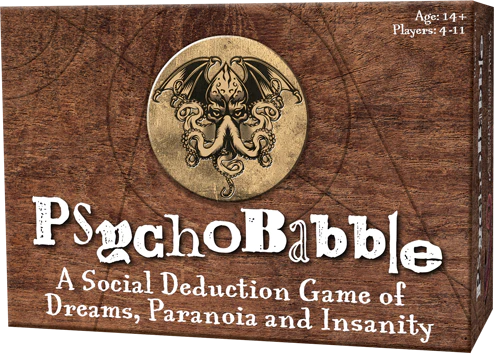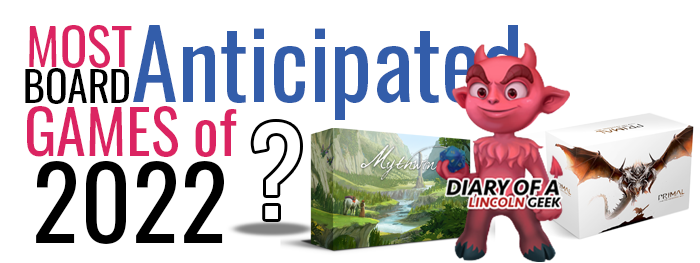What did you say? Sounds like "Psychobabble" to me!
- George E Ohh

- Jul 29, 2022
- 6 min read
Updated: Sep 23, 2022
We were introduced to Psychobabble at the UK Games Expo this year when we got to talk with the designer Kedric Winks. It was a great conversation and is linked at the bottom of the review if you want to check it out. One thing that came up in the interview was the beauty of the artwork by Eric York being the main inspiration for the game.
The game has such a unique take on the social deduction genre and got us hooked so here are our thoughts...

Players: 4-11 | Ages: 14+ | Game Time: 30 mins |
Summary
Psychobabble is a social deduction game for 4 -11 players designed by Kedric Winks based on the amazing art of Eric York and is produced by Cheatwell Games (www.cheatwell.com).
Set in the Lovecraftian universe, all the artists are predicting the rise of the great Cthulu, the mere morals of society unaware of the premonitions have deemed them insane and have sent them for treatment at the Asylum.
Can you determine the truth from the Psychobabble?...
One player is the therapist whose job is to determine the true lunatic from the artists with their shared vision via a group therapy session, with questions being asked around the group in turn.
Gameplay
One player will be the therapist who will act as a sort of pseudo gamemaster for the game and will be responsible for some of the set-up elements. The rest of the players are patients and will be given a dream card, which combined with the dice result will indicate which image represents their dream. Players’ win conditions are slightly different depending on their role:
The therapist will win if they can identify the shared dream that the patients are talking about
The patients win if they can identify the insane patient among them
The insane patient wins if neither group guess correctly.
Set-up is pretty simple, with 16 dream cards laid out in a 4x4 grid. It is recommended that each row contain only cards from one suit, so you should shuffle the suits separately when randomising the set-up.
The therapist prepares the cypher cards to give out one to each member of the group so that all but one patient has the same key (the player with the card that is different is the lunatic) . For example, in a six player game the therapist might select four cypher cards from pile A and one from pile C to make up the five dream cards for the patients, with the therapist being the sixth player. These cypher cards are then shuffled and one is dealt to each patient. The therapist then rolls the two dice (D6) included so the patients can locate the corresponding dream card they will be describing by comparing the result of the dice to the key on the cypher card.

Now we go into the group session... a play in three acts:
ACT I: The first set of statements is made by the patients going clockwise round the circle starting with the player to the left of the therapist. They will each make a statement about the dream they've seen.
ACT II: Now the session really gets going and each player gets to ask one other patient a question about their dream.
ACT III: The finale, now the therapist asks each patient a final question to gather the last bits of information for their report.
So we now get to end-game. The therapist will place the dice on the dream card they think is the shared dream between the patients. If it's correct they win, if not then patients get their chance to identify the genuine insane patient for their chance to win. If they both fail then the lunatic wins.
It's really that simple!
Whilst you may need to be a little obscure in how you phrase your answers to avoid giving anything away too easily, there is no need to lie at all! It's this same element that is the biggest deviation from the genre that is probably the thing we like the most... It can be such a polarising element for many and can lead some to really dislike social deduction games entirely.
With simple components and the elegant conciseness of the game concept you can easily adapt the game to suit your needs and means there are loads of variants you could consider.
A couple of our favourite ideas are:
Got a larger group? No problem just change it to a team game where instead of just a single lunatic there are separate groups of patients with their own unique dream! All you have to is sort them in the right groups. Now you can get your game to accommodate a huge player count of up to 37!
Trapped inside and only have your regular game partner? Make it an interview where you each have a dream card and have take it in turns to ask questions until one of you is ready to guess and try and identify the dream of their partner.
Production
So the production of this is broadly speaking great. Other than two plastic dice, the whole thing is just cardboard so big thumbs up on the environmentally friendly thing. Or at least up to a point... material choice alone doesn't make something environmentally friendly (I feel a separate article coming on here at some point), and well I was little disappointed by the excess space in the box filled with a carboard box insert when a smarter box design could have made the game compact and easy to transport. I suspect this was ultimately to ensure it had suitable shelf appeal for the retail market but it still feels like a missed opportunity.
So the card stock used is good and the box insert while it may be a little tight should accommodate card sleeves if that's your preference..
Right let's stop beating about the bush here with these minor tid-bits... and get to what this game is really about. It’s the absolutely gorgeous artwork on the large dream cards by Eric York in his distinctive black and white style. They match the theme perfectly, one part Rorschach painting and one part chaotic Lovecraftian nightmare. They are just so evocative and really make the game the absolute triumph that it is. With each suit having a shared background, they can be seamlessly laid out to form a story of sorts, all sharing common themes and items that makes identifying an individual piece oh so difficult. Where the mechanics are simple the artwork is the glue that gives this game an elegance and deviousness that seems to appeal to all gamers.
Before we sum up, please check out our interview with the designer Kedric Winks when we caught up with Cheatwell at the UK Games Expo 2022.
Conclusion
So let's break it down for you in our key areas:
Replayability | The game has 4 suits of 12 cards each, so with only 16 used per game the number of combinations is seemingly endless. That coupled with the differing layouts and dream combination, make this practically infinitely replayable for as long as you want to. |
Production Value | There's nothing wrong with it, but I feel like there were opportunities to condense this into something more portable and just a little more environmentally friendly. |
Theme | Yeah I'm a sucker for Lovecraft, you caught me, and the artwork by Eric York with the stark black and white is epic so top marks here for me. |
Complexity | As with most social deduction games the complexity is driven by your game group from simple question and answer to complex social bluffing and subtle subterfuge. |
Rules | The game is so simple it takes five minutes to teach. The small rule book has a great amount of explanatory diagrams, my only concern is the small font size isn't particularly accessible. |
Uniqueness | Social deduction game where lying isn't required... feels pretty unique to me. |
Value | It's at a price point where it's easily affordable in the market and good value for money even if the box implies it contains more... |

Overall, while I have some minor suggestions about the product as a whole they are mostly from a personal preference and ethical standpoint, so I can't find anything to not love about this game. It gets top marks for me, a 6/6 on the die scale and a solid RECOMMEND!
Your friendly DoaLG rules lawyer George E Ohh

I enjoy social deduction games for the most part, however I know that I am usually a terribly easy read for most groups I play games with. This usually leaves me only two options: first is to simply play straight and honest and the other is to
simply try to cause confusion for the sake of it. However, the clever mechanics of Psychobabble almost entirely eliminate this. The random set up with no special actions, reveal/attack phases, or roles (other than shrink and patients) means that no-one truly knows if they are sane or a psychotic pawn of dread Cthulhu. This means that lying is almost irrelevant and answers need only be honest but vague. Additionally, the selection of artwork is great in the deduction game process. Many pictures have common themes and elements and it is so much fun to try and extract specifics from your fellow players and find the true loony amongst you. The production value of the game is very good, cards are of a decent stock and being virtually plastic free is always a plus. The show stopper here though is the simple elegant and truly surreal black and white artwork. It is beautiful and the skill in which common elements have been distributed through the cards to create a rules-light game with immersive intrigue is truly impressive. This game truly lives up to the spiel of 'a social deduction game for those who hate (or suck at) social deduction games'. It probably comes as no surprise to you that I also rate Psychobabble as a 6 on the DOALG D6 scale.
Sam-Wise

I will freely admit that I am not a massive fan of social deduction games purely because I am no bluffer, however this game mitigates the need for bluffing / lying and without a doubt defines a new entry into the social deduction category, this is solid and the art work is STUNNING. Without a doubt this is a must for the FAN or NOT A FAN of the category "social deduction", I highly recommend if you're reading this to CHECK IT OUT now!
Chris - Founder/Talent










































Comments